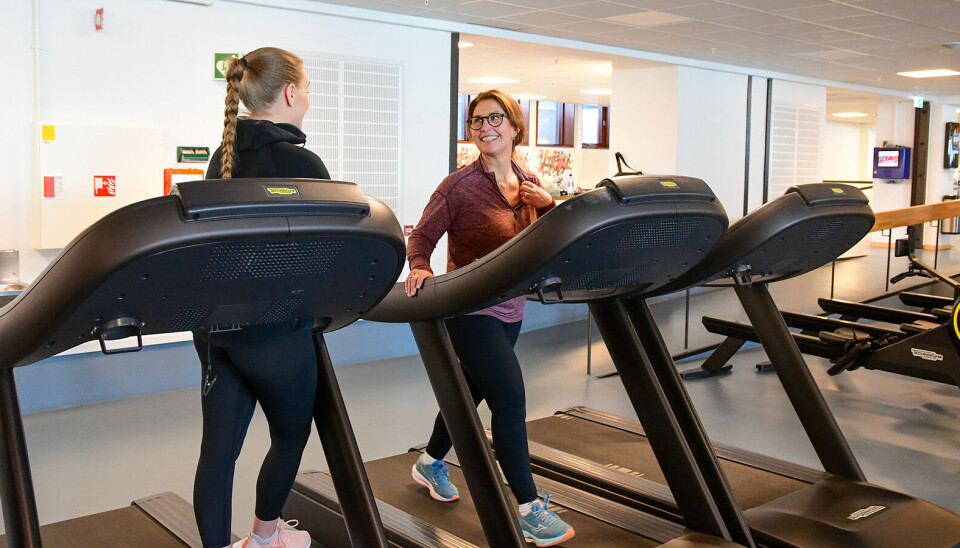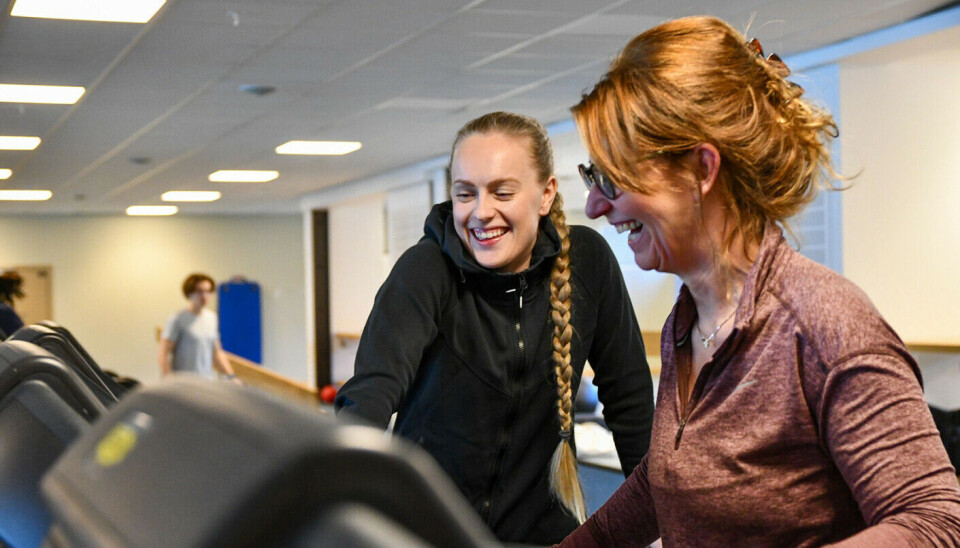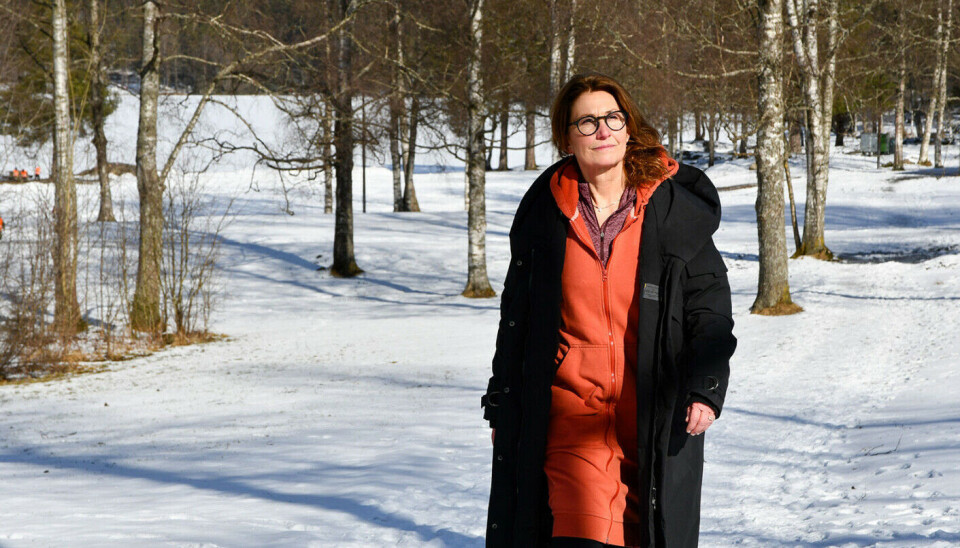THIS CONTENT IS BROUGHT TO YOU BY The Norwegian School of Sport Sciences - read more
Cancer survivor Monica trained for five months: The results are remarkable
"Our findings show that exercise should be included as part of rehabilitation after cancer treatment," says researcher Sara Hassing Johansen.

Monica Hjertholm smiles as she enters the gym and sees the rows of treadmills.
“We sure had fun here!”
She had never set foot on a treadmill before agreeing to participate in the research project.
Ten years after being diagnosed with breast cancer as a young mother one summer day at her cabin, she was about to test the limits of her body.
Would her body tolerate interval training? Would she experience the same benefits from exercise as women her age who had never had cancer?
Awaiting the research results
Monica returns to the Norwegian School of Sport Sciences (NIH) with a completely new outlook on exercise than when she started in this project.
But she has many questions: What did the results from all the physical tests reveal? What has exercise meant for her and the rest of the cancer survivor group?
Today, she gets her answers.

Monica has reconnected with her trusty treadmill after five months of training at NIH.
Researcher Sara Hassing Johansen stands beside her, cheering her on, just like she did three days a week during the project. She has completed her PhD at NIH's Department of Physical Performance.
“You were absolutely incredible. I almost had to carry you off the treadmill because you were having so much fun and pushing yourself so hard,” laughs the researcher, who also acted as Monica's personal trainer during the project.
Higher risk of cardiovascular disease
Thanks to earlier diagnosis and improved treatments, the prognosis for breast cancer is generally good today.
But even though many survive, women who have had breast cancer face a range of long-term side effects, including reduced physical fitness, fatigue, and lower quality of life.
Studies show that over 50 per cent of survivors still experience significant side effects eight years after their diagnosis.
Cancer survivors like Monica also have a higher risk of developing cardiovascular diseases that can be just as serious as cancer.
Undergoing cancer treatment also reduces oxygen uptake by nine per cent during a 13-week treatment period, according to a review study that is part of the NIH research project.
However, the specific effects of exercise on this group remain unclear.
For the researchers, the big question was what kind of training effect Monica and the rest of the group who had undergone difficult cancer treatments could realistically achieve.
Do they benefit from interval training as much as everyone else?
“There has been little research on how the body responds to exercise ten years after cancer. It's only been hinted at in the literature, and no one has included a reference group like we have,” says Johansen, about the study that is the first and largest randomised controlled study on women who had breast cancer some time ago.
Johansen and her research team have spent the past 2.5 years analysing the results from the many physical tests Monica underwent.
Time and again, the researchers were surprised.
None of the women exercised regularly before
The project, called The Cause, recruited 140 breast cancer survivors.
All participants had been diagnosed with breast cancer 10–15 years earlier, and had an average age of 59.
It wasn’t until four years ago that I could even look at myself in the mirror after my illness. I thought I had become ugly.
None of them exercised regularly before the project.
The women were divided into two groups. One group followed a tailored training programme with a personal trainer three times a week.
The other group served as a control group and had no scheduled exercise sessions. Additionally, 70 women without a history of cancer participated in the same training programme as a reference group.
Although the cancer survivor group was relatively healthy, many struggled with lingering side effects and fatigue at the start of the study.
Couldn’t look at herself in the mirror
Johansen takes us into an empty classroom at NIH to share the findings with Monica.
Monica was one of the participants who had felt the lasting impact of the harsh cancer treatment all these years.
“I absolutely have. But even so, I’ve been adamant that it wouldn’t define my life,” she says with a determined smile.
To others, the 57-year-old may have seemed strong and unaffected. But that wasn’t how it felt on the inside.
“It wasn’t until four years ago that I could even look at myself in the mirror after my illness. I thought I had become ugly. You can come to terms with that, but it changes you and your relationships with other people. You become different,” she says.
The researcher nods in acknowledgment.
She recognises this sentiment from the many responses she has analysed in recent years.
On average, the breast cancer survivors scored lower than the healthy group in terms of life satisfaction.
But something remarkable happened when they answered the same questions five months later.
“We hadn't planned to investigate this and were honestly quite taken aback,” says Johansen.
The breast cancer group showed significant improvements in fatigue, quality of life, body image, sleep, and physical function.
In fact, they even reported higher life satisfaction than the group that had never had cancer.
Monica noticed the change when the group reunited.
“The first time we met, everyone talked about how sick they were and how sad everything was. After the training period and the second round of tests, people were laughing and talking about their great results. It was like being on a completely different planet,” she says.
The reference group had double the training effect
Now it’s time to put the facts on the table.
Monica is about to learn what the research team discovered regarding the physiological effects of exercise on breast cancer survivors and, most importantly, how these results compare to the reference group, which did the same training but had not had cancer.
Monica doesn't hide her anticipation.
Was the training effect just as good?
“Even though the reference group did exactly the same training, our findings show they had double the effect on their maximal oxygen uptake. They increased by an average of 2.6 millilitres per kilogram of body weight per minute, while the breast cancer survivors increased by 1.2 millilitres. This confirms what we’ve suspected – that cancer treatment unfortunately has a long-lasting impact,” the researcher says, looking at Monica.
“There’s clearly something physiological that still affects you. These are women like you who were treated over ten years ago. Now we need to find out whether it's rooted in the heart, lungs, or muscles,” she says.
The news is difficult for Monica to digest.
“That we’re still so far behind the healthy group is a bit painful to hear. At times, I can understand it, but I’m not willing to fully accept it,” says Monica.
Walks bring joy and energy
Monica takes us along as she heads out for a walk, the sun shining on her face. These walks, preferably uphill and surrounded by forests and birdsong, have become her go-to activity in her daily life.
Though the treadmill brought her immense joy during the project, outdoor walks are now what bring her the most joy and energy.

She has come to enjoy the feeling of her pulse rising and pushing close to its maximum, something she had never experienced before.
Fortunately, Johansen also has good news to share on the walk.
“Just the fact that you managed to increase your oxygen uptake is fantastic. It’s an important health indicator that we know reduces the risk of many diseases,” the researcher says.
Able to play with her grandchildren again
The positive news doesn’t stop there.
The researchers were amazed by the questionnaire results. Originally, this was just meant to be a bonus.
Now it has become important findings showing just how essential exercise can be for this particular group.
“In addition to improved oxygen uptake, we found that those who completed our training programme reported less fatigue, improved body image, better sleep, and enhanced quality of life,” says Johansen.
At the beginning of the study, 20 per cent of the group reported suffering from fatigue. Interestingly, those who struggled the most at the start were also the ones who experienced the greatest benefits from the training programme.
"It’s one thing whether your oxygen uptake is 27 or 28 millilitres, but what truly matters for these women is how they feel about themselves. Just the fact that they say they have the energy to play with their grandchildren again or go cross-country skiing is incredibly positive," the researcher says.
Felt like she was flying out of the gym
Monica smiles easily. But the joy she felt after completing intense interval sessions during the research project was unlike anything she had experienced before.
“I felt like I was flying every time I walked out of there. I was so happy and experienced a level of joy from exercising that I'd never felt before,” she says.
Monica, who traded city life for farm life, felt stronger, had more endurance, and slept better.
Life simply became better.
Now they hope the study can inspire new cancer patients to discover this joy during their treatment.
“Of course, the most important thing is to recover from cancer. But perhaps the healthcare system hasn’t thought enough about how patients are still vulnerable to a range of issues once they leave the hospital,” says Johansen.
Integrating exercise into cancer rehabilitation
Johansen refers to lingering issues like fatigue, reduced quality of life, and other risk factors.
The research team hopes their findings will help make exercise a regular part of cancer treatment and rehabilitation.
“We’re making progress, as 22 of our hospitals now have Pusterom gyms for cancer patients. But up to now, it has largely depended on whether a patient’s doctor prioritised exercise or not. When a doctor schedules an MRI on Monday, they should also schedule a session with a health and exercise physiologist at Pusterommet on Wednesday,” she says.
It’s also crucial to tailor exercise to the individual.
The researcher, who has extensive experience as a personal trainer, says cancer patients and survivors are one of the most challenging groups to train.
“Cancer treatment affects people differently, which makes this an extremely varied group. Some have lymphedema in their arms, while others struggle with fatigue. This highlights the need for close follow-up by trained professionals,” she says.
Keep a training journal
Monica has no doubt about what she would recommend to other cancer patients.
“I would keep a training journal. Not all days during treatment are the same. Some days you’re so sick you can’t get out of bed. And that’s completely fine,” she says. “On other days, you might be able to get out, even if it's just 100, 500 metres, or a kilometre. Write it down and make it a competition with yourself. Find a group or activity that suits you."
Perhaps exercise, whether it involves intense intervals or just a brisk walk, can bring great joy to more people like Monica, even after enduring tough cancer treatment.
Reference:
Johansen, S.H. From Cardiorespiratory Limitations Across the Cancer Continuum to Aerobic Exercise Benefits in Cancer Survivors: The Effects of Exercise Therapy in Breast Cancer Survivors, Doctoral dissertation at the Norwegian School of Sport Sciences, 2025.
———
Read the Norwegian version of this article on forskning.no

This content is paid for and presented by The Norwegian School of Sport Sciences
This content is created by The Norwegian School of Sport Sciences' communication staff, who use this platform to communicate science and share results from research with the public. The Norwegian School of Sport Sciences is one of more than 80 owners of ScienceNorway.no. Read more here.
More content from The Norwegian School of Sport Sciences:
-
Football expert wants to change how people watch football at home
-
Kristine suffered permanent brain damage at 22: "Life can still be good even if you don’t fully recover"
-
Para sports: "The sports community was my absolute saving grace"
-
What you should know about the syndrome affecting many young athletes
-
New findings on how athletes make the best decisions
-
Is the body just as strong after seven days of fasting? The findings surprised researchers




































